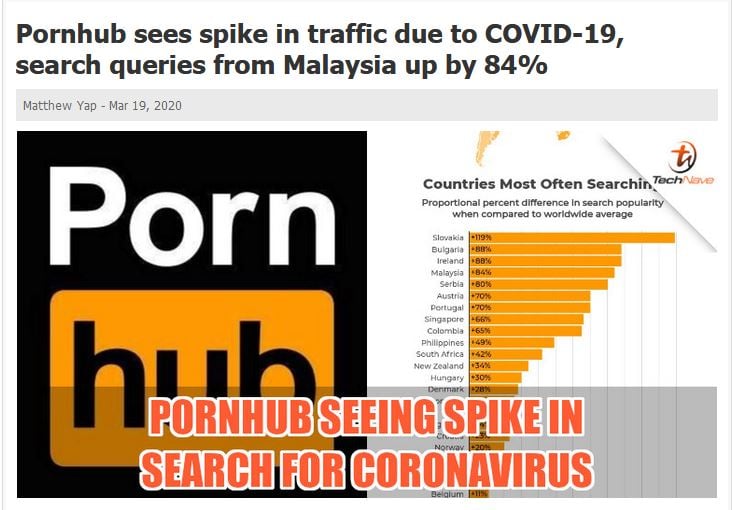Journal of Behavioral Addictions
Authors: Gemma Mestre-Bach 1 , Gretchen R. Blycker 2 , 3 and Marc N. Potenza[email protected] 3 , 4 , 5 , 6 , 7
Abstract
With the global expansion of the COVID-19 pandemic, social or physical distancing, quarantines, and lockdowns have become more prevalent. Concurrently, Pornhub, one of the largest pornography sites, has reported increased pornography use in multiple countries, with global traffic increasing over 11% from late February to March 17, 2020. While some substantial increases have coincided with Pornhub making its premium services free to countries in lockdowned or quarantined jurisdictions, countries without such free premium access have also reported increases in the range of 4–24%. In addition, pornography searches using the terms “coronavirus”, “corona”, and “covid” have reached more than 9.1 million. In this letter, we discuss COVID-19-related pornography-use patterns and the impact they may have with respect to problematic pornography use.
Online pornography use has become prevalent worldwide (Luscombe, 2016). The Pornhub website reported over 42 billion visits during 2019, averaging 115 million visits daily (Pornhub, 2019).
During the COVID-19 pandemic, rapid changes have influenced many people in multiple ways. Pandemic-related social, financial, health, occupational, and other stressors may impact people’s motivations to engage in potentially addictive behaviors, including on the internet (Bonenberger, 2019). During stay-at-home and social-distancing mandates and other COVID-19-related events, Pornhub has noted a worldwide increase in pornography use of 11.6% on March 17, 2020 relative to prior average days (Pornhub, 2020). Over a month-long period from February 24/25, 2020 to March 17, 2020, all 27 countries, for which data were provided, showed increases in pornography use, typically ranging from 4 to 24% (Pornhub, 2020). However, in jurisdictions, in which Pornhub made its premium services free given quarantines and stay-at-home mandates, more substantial increases were observed: 57, 38, and 61% increases in Italy, France, and Spain, respectively, each occurring a day after free services were offered (Pornhub, 2020). On March 17, changes in daily patterns of pornography consumption were observed in Europe, with the most substantial increases (at local times) seen at 3a.m. (31.5%) and 1p.m. (26.4%) (Pornhub, 2020). Largely, similar patterns were observed in other regions including in the US and Asian jurisdictions, especially with respect to early-morning viewing (Pornhub, 2020). These findings, similar to those during a government shutdown (Pornhub, 2020), raise questions about the impact of potential sleep and work disruptions on pornography-use behaviors. Alternate explanations (e.g., viewing pornography secretively after a partner goes to sleep, as is reported by people in treatment for problematic pornography use (PPU)) also warrant consideration based on clinical experience (Brand, Blycker, & Potenza, 2019; Blycker, unpublished clinical observations).
On January 25, 2020, Pornhub recorded the initial use of the search term “coronavirus,” and its past-30-day use as a search term, along with “corona” and “covid,” increased substantially thereafter, exceeding 9.1 million searches (Pornhub, 2020). While it is currently unclear what may motivate such searches, altered event-related content searches have followed other changes/deprivations; e.g., during a Fortnite server crash, increases in searches for Fortnite-related pornography were reported (Castro-Calvo, Ballester-Arnal, Potenza, King, & Billieux, 2018). Moreover, the substantial number of searches for covid-related pornography suggests that it may warrant additional investigation.
The above-described patterns of pornography use raise questions about potential relationships to PPU and health concerns. Stress may exacerbate mental illness or problematic/addictive behaviors (Sinha, 2008), and changes in timing and frequency of pornography use and their health correlates require additional investigation. Furthermore, changes in pornography-viewing content should be studied, particularly given reports that individuals in treatment for PPU often report having viewed more extreme pornography over time (Brand, Blycker, & Potenza, 2019).
The above-described pornography-use behaviors should be interpreted cautiously, especially since COVID-19-related phenomena may change rapidly and longer-term consequences are not known. However, data may provide insight into how individuals may cope with forced confinement, stress, and/or free pornography access. COVID-19-pandemic-related circumstances may also limit casual sex and other behaviors, so individuals may use pornography as a coping strategy. People with PPU may also relapse to pornography use in the setting of feeling powerless, hopeless, and disconnected from 12-step support systems, as has been seen in substance addictions (Donovan, Ingalsbe, Benbow, & Daley, 2013; Blycker, unpublished clinical observations). Generally, pornographic materials may distract individuals from loneliness, distress, boredom or other pandemic-related negative emotions (Grubbs et al., 2020). These and other possibilities warrant direct examination.
Increases in pornography use may signal PPU (Brand, Blycker, & Potenza, 2019), an entity linked to specific psychological and biological mechanisms (Gola et al., 2017; Stark, Klucken, Potenza, Brand, & Strahler, 2018). As PPU has been associated with functional impairment, emotional avoidance, decreased productivity, and psychopathology (Baranowski, Vogl, & Stark, 2019; Bőthe, Tóth-Király, Orosz, Potenza, & Demetrovics, 2020; Fineberg et al., 2018; Kor et al., 2014), more research is needed on pornography-use patterns worldwide, as is careful analysis of the prevalence and correlates of PPU during and after the COVID-19 pandemic. As high-frequency use of pornography may occur in the absence of self-reported PPU, research is also needed into other factors that may underlie or relate to frequent use of pornography (e.g., reducing stress, obtaining sexual pleasure, or fulfillment of other desires or needs; Bőthe, Tóth-Király, Orosz, Potenza, & Demetrovics, 2020). However, for those experiencing pornography-use-related distress or problems, online self-help forums (e.g., NoFap, Reboot Nation, or online 12-step forums focusing on sex and love addiction) may represent important resources. Additionally, it will be important to examine the extent to which any changes during the COVID-19 pandemic are shorter-term adaptations or longer-term patterns of behaviors, particularly if these behaviors lead to personal or interpersonal distress or harms.
